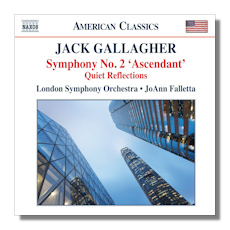
The Internet's Premier Classical Music Source
Related Links
- Gallagher Reviews
- Latest Reviews
- More Reviews
-
By Composer
-
Collections
DVD & Blu-ray
Books
Concert Reviews
Articles/Interviews
Software
Audio
Search Amazon
Recommended Links
Site News
 CD Review
CD Review
Jack Gallagher

Modern Masterpiece
- Symphony #2 "Ascendant"
- Quiet Reflections
London Symphony Orchestra/Joanne Falletta
Naxos American Classics 8.559768 75:08
Jack Gallagher (b. 1947) is an American composer with a fairly substantial output that includes orchestral, chamber, solo instrumental, choral and vocal works. The Symphony #2 (2010-2013) is certainly one of his most ambitious compositions: consisting of four large movements and lasting over an hour, it has an epic character and heroic sense that bespeak a deep expressive manner. While his music sounds nothing like Mahler's, his symphonic conception and musical ideas call Mahler to mind, at least in some ways: this is a big work with a purpose and colorful personality, almost taking on a whole world of expression. Unlike Mahler, however, Gallagher is less prone to express angst and tragedy, and more likely to impart a sense of optimism and triumph.
Other perhaps more relevant comparisons about Gallagher's music can be made. If his style occasionally hints at Bartók or Hindemith or David Diamond, Gallagher never really comes across as imitative in those moments. In fact, he is one of the more original contemporary composers you're likely to encounter, and that's saying a lot considering the undeniable fact that it's very difficult to sound totally original when you compose in a tonal, quite conservative style as Gallagher does. Regarding that style – it sounds as much European as American in the symphony, which is quite an irony because Gallagher's teachers include Elie Siegmeister, Robert Palmer, and Burrill Phillips.
The symphony's twenty-minute first movement, marked Boldly, bristles with energy for the most part, though there are contrasting slow sections. It opens as if the music is breaking out of a starting gate, the horns leaping upward with a trenchant theme and the orchestra swirling with energy and tension. A quiet theme on oboe and harp has a slightly Bartókian flavor in its exoticism, and the development section is quite imaginative in its colorful orchestration and handling of the thematic materials. The composer, who has written the album notes, mentions a passage on three trumpets that pays homage to Stravinsky's Petrouchka (about midway through the first movement), but it is only brief and very little else in this work sounds Stravinskyan. By the way, the symphony's subtitle, Ascendant, refers to the upward motives of the horns in the opening, motives or themes that permeate much of the work thereafter.
The second movement, marked Playfully, is at 9:33 the shortest of the four panels here. It is indeed "playful" and has a sort of Central European exotic manner in its colorful orchestration. The composer mentions its nearly perfect palindromic structure: ABCD E DBA. Overall, this is an utterly delightful movement. The third movement, marked Slowly, begins in a dreamy mood with materials from the symphony's opening but gradually begins seething with tension. Midway through the accumulating tension is vented via a brief dissonant and angry episode, also containing materials from the first movement. The dreamy but somewhat restless mood returns and the movement closes quietly. While this third panel has much attractive music during its sixteen minute-plus duration, it comes across as a bit overlong.
The same observation may be made about the finale. Marked Slowly–Energetically–Fast–Moderately–Fast, it is about as long as the third movement, but somewhat more colorful and varied in mood. Following the slow opening the energetic section has a very mid-20th century American sound: the music is agitated and very busy in the strings but muscular in the brass writing. Tension builds as materials repeat insistently and after a brief quiet but restive passage, the music's drive and tension return. Ambivalence reigns, it seems, as the music struggles, teetering on the brink of either collapse or triumph. But finally the mood brightens and the symphony ends in triumph.
If you can hear both a European and American character in the symphony, you'll be hard pressed to find that duality in Quiet Reflections (1996), a clearly more native than foreign sounding work. The music, while austere in a few places, is generally bright in mood or gently reflective. The middle section vaguely hints at Copland for a moment, particularly from Appalachian Spring. But the music in the outer sections remains true to the mood suggested in the title. It's a pleasant sort of dreamy work that lacks the more distinctive character of the symphony.
The performances, both recording premieres, sound very excellent to me, as JoAnn Falletta seems to have a total emotional and intellectual grasp on Gallagher's style. The London Symphony Orchestra plays with great commitment and spirit for her. The sound reproduction is excellent. Now, the big question – is the music on this disc worth your attention? Well, it offers many rewards and I think the symphony may well stand alongside some of the better ones by American composers from previous generations like Hanson, Harris, Mennin, Diamond, Creston, and Piston. I make that comparison because Gallagher's style falls more into the time frame of those composers. Thus, from the evidence here I would say Gallagher is at least a significant composer from his generation, but in time he may well come to be regarded as one of the more important American composers from the turn of the century era.
Copyright © 2015, Robert Cummings




















